
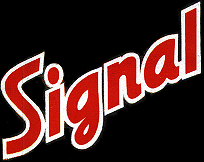 | Signal. Sonderausgabe der |
|---|
[ Documents & Research ] → Deutscher Verlag memo dated February 15, 1945
I. Introduction
This file note dates from the final months of the war, at a time when the greater number of Signal's editions had already been discontinued. The countries in which they were supposed to be distributed had since come under enemy rule. Even so, the Wehrmacht's High Command (OKW) and the Deutscher Verlag were still, in February of 1945, deliberating which editions should be published in the future. Surprisingly, this included languages to which there was no addressable readership anymore – unless, that is, we consider foreign volunteer formations.
Perhaps the greatest surprise in this respect is the possibility that a Spanish edition may have been published in 1945. While thought to having been discontinued in the summer of 1944, this document substantiates the chance that the edition may have been relaunched in 1945, quite possibly targeting the handful of Spanish volunteers still fighting on German side.
Document source: originally located in the Ullstein archives, it should now reside in the Unternehmensarchiv (corporate archive) of the Axel Springer publishing group. To this date, however, I have not been able to locate it. When still part of the Ullstein archives, the file was sent, in a xerox copy, to Italian researcher Stelio Millo, who used it for his "Signal-Dossier".
II. Transcript of the original German document
Akten - Notiz
- - - - - - - - -
In der heutigen Besprechung zwischen Vertrieb und Druckerei wurde festge-
legt, welche Sprachausgaben "Signal" in Zukunft noch gemacht werden sollen.
Voraussetzung für die Durchführung dieses Planes ist, dass die Ausweich-
setzerei Tempelhof 3 weitere Setzmaschinen betriebsfertig hat.
Es besteht Übereinstimmung, dass folgende Sprachausgaben von Major Solm,
vom Vertrieb und von der Druckerei gewünscht bzw. hergestellt werden:
Deutsch
Ungarisch
Schwedisch
Französisch
Englisch
Holländisch
Italienisch
Norwegisch
Russisch
Damit wäre die Kapazität der Setzerei bezw. der Mettage erschöpft, solange
ein 14 tägiger Turnus des bisherigen Heftumfanges durchgeführt werden soll.
Vom Satzmaterial und Matrizen her gesehen könnte von der Druckerei gesetzt
werden: Bulgarisch
Portugiesisch
Dänisch
Spanisch
Kroatisch
Nicht mehr gesetzt werden können:
Polnisch
Slovakisch
Rumänisch
Serbisch
Lettisch
Estnisch
Der Vertrieb wäre ausser den anfänglich genannten 9 Sprachen interessiert an:
Slovakisch (kann bei uns nicht mehr gesetzt werden)
Dänisch
|
- 2 -
Das OKW hat noch Interesse ausser den erstgenannten 9 Sprachausgaben an:
Bulgarisch
Rumänisch (kann bei uns nicht mehr gesetzt werden)
Lettisch " " " " " " "
Estnisch " " " " " " "
Kroatisch
Serbisch (kann bei uns nicht mehr gesetzt werden)
Spanisch
Es wäre die Überlegung anzustellen, ob einige Sprachausgaben in vierwöchent-
lichem Turnus erscheinen sollen, um eine grössere Zahl von Sprachausgaben
in den Satz bringen zu können.
[Signatur]
15.2.1945
[Paraphe]
|
III. English translation of file note
File note
- - - - - - - - -
In today's conference between the sales department and print office it was
agreed which language versions [of] "Signal" should still be produced in the
future. The requirement for the execution of this plan is that the alternate
case room [at] Tempelhof 3 will have three additional typographs in working
condition.
There is agreement that the following language editions are required by Major
Solm, the distribution office, and the print office, and [that they] will be
produced:
German
Hungarian
Swedish
French
English
Dutch
Italian
Norwegian
Russian
This would exhaust the case room's capacity, or that of the make-up room
respectively, so long as a fortnightly cycle with the magazine's present
volume is to be kept.
In respect of typesetting materials and templates the print office could
compose the following: Bulgarian
Portuguese
Danish
Spanish
Croatian
The following can no longer be composed:
Polish
Slovak
Romanian
Serbian
Latvian
Estonian
In addition to the above mentioned 9 languages the sales department would
be interested in: Slovak (can no longer be composed here)
Danish
|
- 2 -
Apart from the 9 editions listed at the top the OKW is also interested in:
Bulgarian
Romanian (can no longer be composed here)
Latvian " " " " " "
Estonian " " " " " "
Croatian
Serbian (can no longer be composed here)
Spanish
It is worth considering if some language editions should be published in a
four-weekly cycle, in order to be able to prepare a greater number of editions
for the typesetting.
[signature]
02-15-1945
[paraph]
|
IV. Analysis of D-V file note
Last updated March 13, 2004.
1. The memo is dated February 15, 1945. Assuming the 1945 printing of Signal commenced right at the beginning of the new year, this should mean that, at the time the memo was written, issues 1/45 to 4/45 had already been published. This may not be too likely though, there is a rather high probability that printing was restarted considerably later – i.e. in January or perhaps even only in February of 1945. Since the relaunch was most probably ordered by the Propaganda Ministry or the Auswärtiges Amt (Foreign Office), it should be possible to establish the exact relaunch date through archival research; until then we have to work with assumptions.
The memo mentions a "fortnightly cycle" of publication, so no matter when exactly Signal was launched again, it had been, at least until this file note was typed, been published in the regular (twice-a-month) frequency again. There were considerations to alter this cycle in the future "in order to [...] prepare a greater number of editions for the typesetting."
2. In further consideration of the relaunch issue, there are conflicting clues which make it very difficult to agree on a likely assumption. The fact that Est and Let 4/45 were demonstrably produced and published may indicate they were printed before the memo was written, as the necessary typesetting material had been destroyed by then – the memo points out these editions could "no longer be composed". It is absolutely possible, however, that German ingenuity and improvisational skills found a way around this.
3. Another (conflicting) aspect is that several sources claim the last issue of Signal was only published on April 13, 1945. (Cf. Mendelssohn, Zeitungsstadt Berlin. Menschen und Mächte in der Geschichte der deutschen Presse, Ullstein 1959, pp. 468-493. Please note that I have no idea where this date originates from, and if it is reliable or not.) This very late date could indicate that the memo was written at a time when only issue 2/45 or 3/45 had already been published. It seems justified, then, to assume the memo was written at a time when issue 3/45 had already been published, but before 4/45 came off the presses. Based on this assumption all subsequent considerations will regard issue 4/45 as the first number of Signal to having been published after the memo was written.
4. Regarding the list of editions that Major Solm, the OKW's liaison officer, and the Deutscher Verlag agreed should be printed: the fact that the distribution office of the Deutscher Verlag was involved in these talks clearly indicates that some of the editions were supposed to be sold, either in their entirety or in part, to the civilian population of a number of European countries. Clearly, not all the editions were 'give-aways' distributed to various foreign volunteer units. | 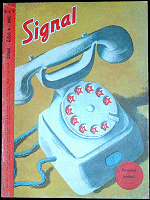 Signal issue 4/45, Slovak edition (click for closeup of code) |
5. In addition to this, we also know of issue 4/45 in an Estonian and Latvian edition by way of reproduction of their contents boxes in Stelio Millo's "Signal Dossier" (codes of these two editions are unknown, Est and Let perhaps?), both of which were definitely targeting volunteer units. It has been suggested they may have been shipped to the Kurland pocket (unverified rumor).
6. A Russian edition of 4/45 has not been confirmed so far, though it wouldn't be a major surprise: it was one of the largest groups of foreign volunteers, and the Russian edition probably wasn't dropped until the very end (also because there was an influential circle of Russophiles in the OKW attempting to maintain good relations with whatever pro-German Russian forces still remained at the time).
7. A Hungarian-only edition has, until very recently, been entirely unknown to us. First evidence for such a version of Signal (which we may expect to have had the edition code U) surfaced in January of 2004, when fellow collector Raimo Kotiranta submitted scans of a possible issue U 11/44. There is a news item on this posted in the news section, dated January 18, 2004.
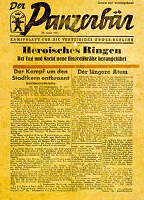 | 8. That several editions could no longer be composed was the result of a devastating bombing raid on Berlin which had laid waste to the Kochstrasse earlier in February. The raid on the morning of February 3, 1945 leveled most of the Deutscher Verlag's building complex, forcing all publishers in the 'newspaper district' of Berlin to relocate their activity to Tempelhof. |
9. Another intriguing aspect is that the sales department expressed interest in the Slovak and Danish editions. This implies they were to be sold to the civilian population in these countries, in order to generate revenue. (As this was, quite obviously, what the sales department was interested in, and not in the propagandistic influentation!) As noted above, both Da and Sl 4/45 have been confirmed. This brings us back to the question which issues of Signal had been published at the time. The file note clearly states that a Slovak edition could no longer be composed, so they either found a stop-gap solution for this, or 4/45 had indeed already been published when the memo was written. Personally I believe the first possibility is more likely than the latter.
10. As a final aspect that is noteworthy, the OKW expressed interest in several other editions: Bulgarian, Romanian, Latvian, Estonian, Croatian, Serbian, and Spanish. We can assume that these were all intended to be distributed to foreign volunteer units, as all the countries in which they had previously been published had since become inaccessible to German propaganda.
The real sensation here, of course, is the Spanish edition. It is not entirely inconceivable that it was to be shipped to Spain, but the purpose of this action must appear questionable – what influence would it have had in Spain at this time during the war? It is much more likely that the Spanish edition was rather requested in order to be shipped to a volunteer unit as well. If this has actually been the case, its readership would have been remarkably small: the Blue Division (250. ID) had been withdrawn from the Eastern Front in June of 1943, and only a group of about 1,500 volunteers remained, who went on to form the Blue Legion. This formation, too, was repatriated to Spain in March of 1944, and with that Spain's official participation in the war effectively came to an end. Franco sealed the border with German-occupied France, thus barring any overt German propagandistic influence in his country. (This is a rather compelling argument against the Spanish edition having been shipped to Spain in 1945.) | 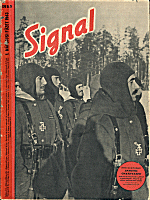 The cover of Signal issue 5/43 featured Spanish volunteers from the Blue Division at the Eastern Front |
The handful of remaining Spanish volunteers, which in 1945 formed one or possibly two SS-Freiwilligen-Kompanien, never comprised more than 450 men. So it must appear curious that an edition of Signal was produced for such an exclusive readership – although it certainly is not impossible.
11. Indeed I have a strong suspicion the even smaller British Free Corps was equally supplied with edition E of Signal, though watertight proof of this has yet to be supplied. | 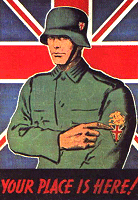 |
12. In summary, we may find that at this time during the war, Signal had become less of a magazine intended to influence civilian populations abroad, but rather a propaganda tool targeting the various foreign volunteer formations of the Wehrmacht and Waffen-SS.
Reader's comments on these considerations, especially on the question of which numbers had been published at the time the file note was penned, are highly welcome.
| Return to top of page | Disclaimer | © 2002 – 2010, Alexander Zöller. |